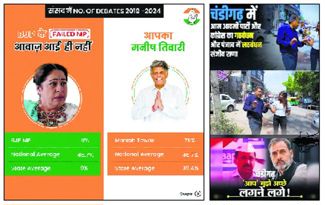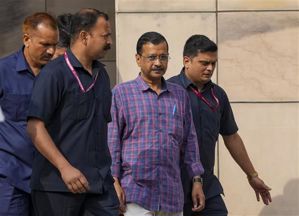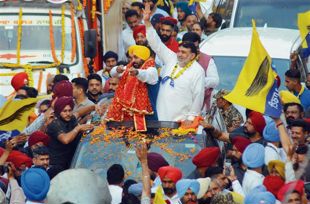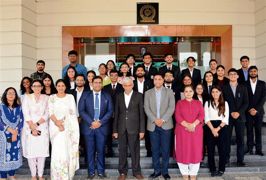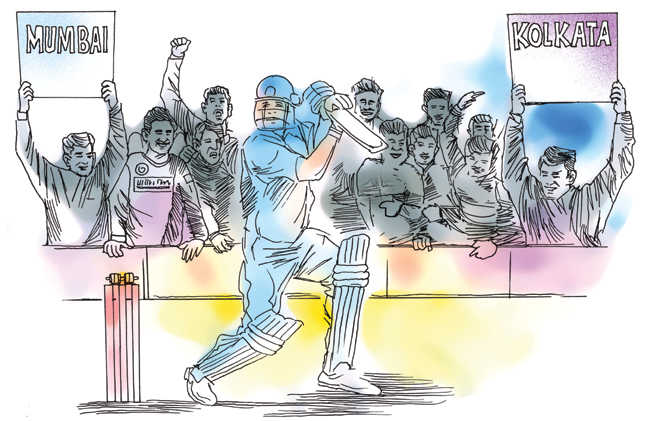
Illustration: Sandeep Joshi
Harish Khare
The Indian Premier League show begins on April 5. As a business proposition, the IPL is a rather dubious ethical project. It tends to attract hot people with hot money. But I am inclined to look forward to the new season for a very different reason. This nightly entertainment, in the guise of cricket, would take us away from the nationalistic fervour of the just concluded India-Australia Test Cricket series. In the end, we won the Gavaskar-Border Trophy not because we are a great country but because we played better cricket — more competent, more intelligent — than the Australians could come up with.
But, thanks to entirely mercantile calculations, the India-Australia Test series was marketed as an occasion to reaffirm our nationhood. A needless aggression was deliberately injected into the game. And, I am inclined to agree with Sourav Ganguly that the Indian captain allowed his emotions to get the better of him and that adversely affected his performance as a batsman. No one should be surprised to be told that probably Virat Kohli’s business managers are coaching him to sound aggressive and passionate, even when he is watching the proceedings from the dressing room. Kohli’s determined aggression is being sold as the comforting expression of a new and confident India.
It is here that the IPL should provide a therapeutic touch to our overexcited “national” emotions. This is a show devised only for the benefit of the television — its viewers and its advertisement revenue. For now, we shall be induced to cheer for this or that “city” team; film stars and other celebrities would be deployed to crank up “loyalty” for this or that team — and, teams are identified with a city (rather than the nation).
Now in the IPL, we will see one set of Australian and Indian players teaming up, strategising, pitting wits and skills against another set of Australian and Indian players on another team. Many teams employ Australian coaches and other technical experts. This mixing up of the cast, so to say, would inevitably mean a different, friendlier chemistry among players of different nationalities. None of the players would be under any kind of pressure to redeem Mother India’s honour; they would all be driven by a desire to retain their place and their hefty contract money.
More than the players dissolving their “nationalistic” passions, much more important would be the impact on the mass emotions of the viewers. The sight of the players of different nationalities playing together in an “Indian” league, under the “Indian” arrangements, should make us take a relaxed and comfortable view.
It is no coincidence that we go out of our way to keep the Pakistani players out of the IPL.
****************************
Manisha Basu is a young scholar and teaches English at the University of Illinois, Urbana-Champaign in the United States. She has written a spectacularly insightful book, The Rhetoric of Hindu India. Though the book is not without its share of academic jargon, it does offer a rather new understanding of the cultural narrative that has made possible the rise of the Hindutva forces. Ms Basu is able to explain how what she calls “metropolitan Hindutva” became so palatable to the middle classes just in the course of last ten-fifteen years. And, her assertion is that the key to understanding the pan-India spread of the Hindutva ideology is a new “politics of language,” and it is this language that has made vast swathes of upper and middle classes as much a partisan of the Hindutva project as are the semi-literate multitudes in eastern Uttar Pradesh.
What is particularly insightful is Ms Basu’s ability to decode Chetan Bhagat and Amish Tripathi, the two cult writers of the “new India”. Chetan Bhagat is not just a bestselling author but also “a marketing phenomenon.” Whereas the older Indian authors, the Salman Rushdies, the Arundhati Roys, and the Aravind Adigas, wrote in an English that most Indian readers found intimidating and stilted, Chetan Bhagat racily addressed himself to the first generation of “call center” English readers. Ms Basu argues that “Bhagat’s readers are youth who for the first time are being exposed to the idea that reading a particular kind of English fiction may help them to get particular kinds of jobs.”
Undoubtedly, Chetan Bhagat is the first Indian writer in English to become a genuine bestselling author, his books can be purchased at railways stations, from Bhagalpur to Bathinda. Ms Basu credits Bhagat for a “clever manipulation of a kind of call center English as the representative Indian national tongue” and it is this “nationally viable, cyber-savvy, managerially endorsed English” that brings together the peripheral and the metropolitan in the service of “the new Hindu India.”
Only after reading Ms Basu’s dissection of Chetan Bhagat and his impact could I make sense of what Prime Minister Modi said during the UP campaign. Declaring that demonetisation was a great success, let it be recalled, the Prime Minister had claimed that it is not “Harvard” but “hard work” that was the key to success. In one go, the Prime Minister was telling the mofussil India to be contemptuous of the self-importantly superior outsiders and their criticism, just as he was reassuring his metropolitan bhakts to not take the indictment from the Harvard crowd seriously.
The strength of Chetan Bhagat, according to Ms Basu, is his ability to introduce a “memoryless journalistic style of metropolitan Hindutva.” The new history is without memory. So “nothing” happened, no progress was made in the 60 years of Nehru’s India.
Bhagat, as Ms Basu dissects, wants a “positive Hinduism” which is “modern, safe, scientific, free, liberal, and ...with good values.” Bhagat had endorsed Modi and posted on his Facebook: “Met#nameo. You know a leader has the youth pulse when he can discuss job creation at length and is still up for a selfie.”
Ms Basu calls Chetan Bhagat and Amish Tripathi as “the new breed of believers” who seek to inject into the old Hindutva project a “new vitality of youth” in a language that is easily accessible to the quasi-literate younger generation.
A difficult book, but nonetheless an insightful read.
****************************
Just as I was meditating Chetan Bhagat’s popularisation of a new type of English, a friend forwarded me a joke that was going around. It is entitled: ‘KILLER ENGLISH by TEACHERS’
PT teacher: You three of you, stand together separately.
Geography teacher: Will you hang that map or else I'll hang myself?
Principal: Tomorrow call your parents, especially Mother and Father.
And the terrific one:
English teacher: Why are you looking at the monkeys outside when I'm in the class!..
It struck me that this precisely was a kind of joke that the “proper English-wallahs” enjoyed at the expense of the newly ambitious “English-speaking class” in the pre-Chetan Bhagat age. We all had a good laugh when an Amitabh Bacchhan would rattle off in Indian accent that “English iz a very phunny language” in Namak Halal.
What the Chetan Bhagats have done is to make us overcome our inhibition about being inadequately familiar with the “phunny” English. It suddenly makes sense why millions and millions of Indians spend billions of rupees each year in having their children educated in the so-called “English-medium” schools. In each of the localities of big and small towns, we find at least one “tinker-bell” pre-nursery school.
It is this Indian-English generation that satisfyingly smirks at the “Harvard’ and ‘hard work’ pun.
****************************
Suddenly, in this festive season, I find that everybody is observing the nine-day Navratra fast, though with variations. Maybe it is the new lifestyle associated with our new rulers. But I have heard two very reasonable explanations in favour of fasting. First: it detoxifies the body of its useless ‘kachhra’ while allowing the fasting soul the blissful satisfaction of a religious experience. The second explanation makes more sense: since time immemorial, India has been a poor country, never self-sufficient in foodgrains; fasting for eighteen days (over two nine-day tranches, in March and October Navratras) automatically meant saving
of wheat/cereals for eighteen days.
I was relieved to be assured on good authority that the protocol of fasting did not include any restriction on coffee. So, do join me.






















